Bac Ha District, located 700 kilometers northeast of Lao Cai Province, attracts visitors with its beautiful natural landscape and historical landmarks. Bac Ha is short for ‘Pac Ha,’ which means ‘hundred alang bunches’ in Tay ethnic language. This area was known as Pakha during the French colony. Vietnamese people pronounced it ‘Bac Ha,’ and this rural district was given that name.
General Information
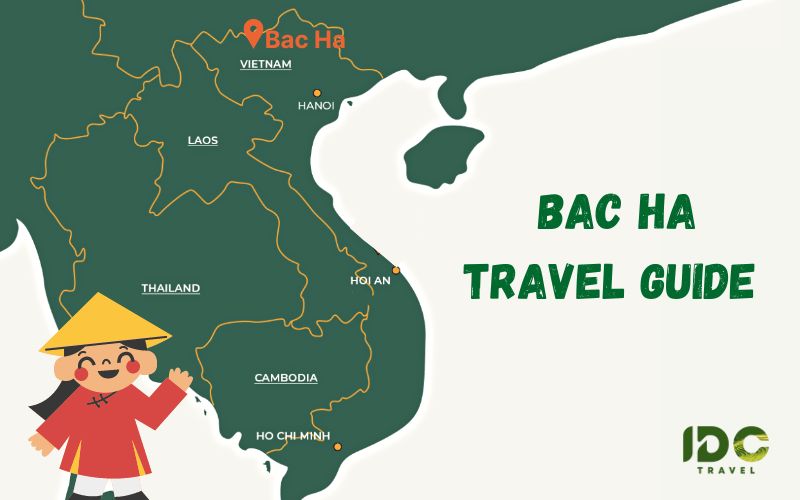
Bac Ha Location – IDC Travel guide
This is an ideal destination for trekkers and culture lovers on a trip to Vietnam because of its majestic mountains, rivers, and caves endowed by Mother Nature, colorful ethnic cultures, and friendly locals. This neighborhood is well-known for its Sunday morning ethnic market, where you can see Northwestern mountain tribes dressed in colorful costumes and trading local products and souvenirs like jewelry, scarves, and wood carvings.
Other attractions worth visiting include Fairy Cave, Hoang A Tuong Palace, Ban Pho Village, and Bac Ha Temple. If you’re feeling daring, rent a motorcycle and explore this peaceful area. The roads are winding and long, but the scenery is spectacular, with imposing alleys dotted with small ethnic houses and emerald rice fields.
Bac Ha is known as a ‘White Alley’ (Cao Nguyen trang) because poppy plants and marijuana were grown in mountainous areas such as Lang Son, Lao Cai, Yen Bai, Lai Chau, and Nghe An between 1985 and 1996. Because the Vietnamese government forbade the cultivation of these addictive substances, the ‘White Alley’ transforms every spring into a peaceful land of plum blossom over the hills, creating romantic scenery for this destination.
Ethnic Minorities in Bac Ha
On a Northern Vietnam tour, you can see a lot of H’Mong people, who make up half of Bac Ha’s population. There are also Tay, Dzao, Tu Zi, Nung, Phula, La Chi, and Lo Lo ethnic minorities.
Bac Ha Weather & Best Time to Visit
Because of the mild weather climate and poetic natural scenery, spring is the best time to visit Bac Ha. From January to April, you can see various types of blossom flowers. They are the cherry blossoms in the Na Co Lake and Bac Ha town areas, the peach blossoms in the Na Hoi – Ban Pho area, and the Tam Hoa plum flower in the Ta Chai, Na Hoi, and Ban Pho areas. Ta van plum flower blooms later in the Lung Phinh – Ta Van Chu – Lung Cai – Simacai travel route. If you visit this district during the summer, be cautious because heavy rains may disrupt your trip.
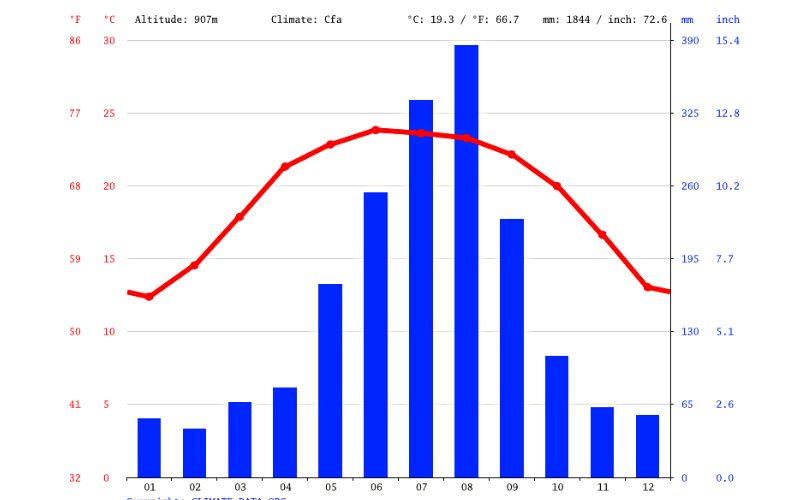
Bac Ha Weather
Some of the best times to visit this location are:
- Peach blossom season occurs in the spring, before and after the Lunar New Year.
- Earth and Water Festival Every year on the 15th of the first lunar month, the greeting is held.
- In March, the hills are completely covered in the white color of plum blossom.
- Water pouring season occurs in May, transforming the rice terraces into breathtaking scenery.
- The traditional Racing Horse Festival takes place in the sixth lunar month after the plum has reached ripeness.
- Bac Ha Market on Sunday
- Temple Festival on the seventh lunar month’s seventh day
- September is harvesting season.
Getting to Bac Ha
- By bus: From Hanoi, take a bus to My Dinh Bus Station and then to Bac Ha. A ticket from Hai Van costs VND 250,000 dong. Buses leave at 9:00 p.m. and arrive in Bac Ha the following morning. Every day, there are 18 buses.
- By train: You can purchase train tickets from Hanoi to Lao Cai, which depart from Hanoi around 8-9 p.m. and arrive in Lao Cai around 5 a.m. Then, from Lao Cai, take a bus to Bac Ha from the Lao Cai Bus Station at 7 a.m., 12 p.m., 1 p.m., and 2 p.m. Tickets are approximately VND 50,000 dong.
- If you want to take both Bac Ha and Sapa tours but don’t want to ride a motorbike, you can take a bus from Bac Ha Bus Station to Sapa.
- We highly recommend hiring a car with a driver if you travel in a group or with family.
Getting around Bac Ha
Bac Ha is a small town best explored on foot or by motorcycle. You can either rent a motorcycle or take a motorcycle taxi (xe om) around town. If you want to visit Bac Ha and other places in Lao Cai, such as Si Ma Cai, Y Ty, or Sapa, you should rent a motorbike in Hanoi and ride here.
Where to stay in Bac Ha
Bac Ha has a wide range of accommodation options, from the town center to the surrounding villages. Let’s look at the list of homestays below for a relaxing vacation in this beautiful place.
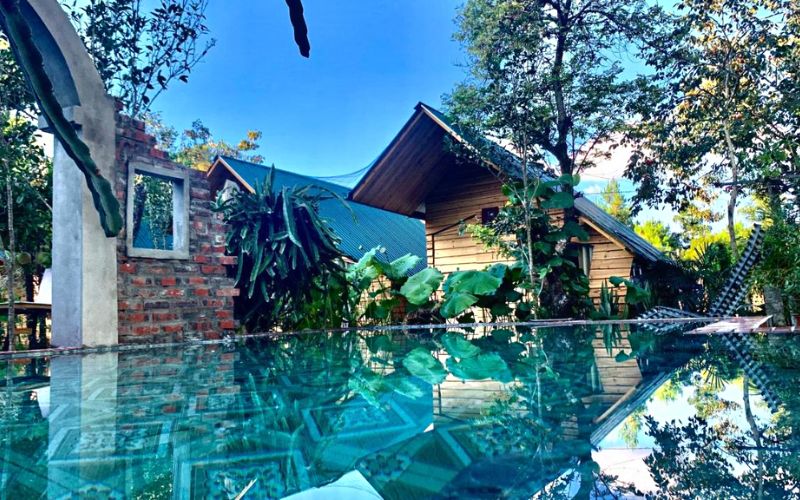
Nobita Homestay
Huy Trung Homestay
- Address: Na Quang 3, Bac Ha town
- Room price: from VND 450,000
- Contact: 097 977 6288
Bac Ha Boutique Homestay
- Address: Na Co, Bac Ha town
- Room price: from VND 120,000
- Contact: 096 842 89 68
So H’mong Homestay
- Address: Ban Pho 2, Ban Pho Commune
- Room price: from VND 100,000
- Contact: 096 323 65 64
Cho Family Homestay
- Address: Phec Bung Village, Ban Pho Commune
- Room price: from VND 100,000
- Contact: 0949 423 221
Places to visit in Bac Ha
It will be exciting to continue your ethnic exploration in Bac Ha after spending time on a Sapa excursion. The main things travelers can do here are trek to ethnic tribes, interact with locals in their market, and admire majestic trails in the midst of the mountains.
1. Ethnic Markets
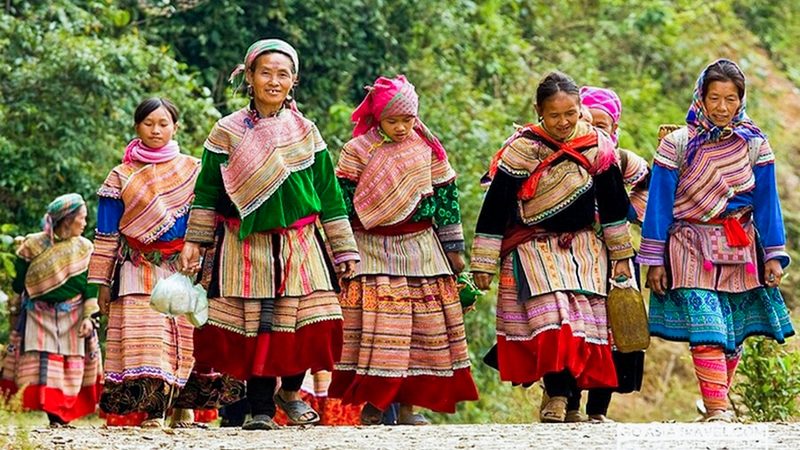
Ethnic women go to Bac Ha market
Sunday Market
- Location: Bac Ha District, 80 kilometers from Sapa
- When visiting this district, it is highly recommended that you spend time at the Bac Ha Sunday Market. Every Sunday, H’Mong, Red Dzao, Ha Nhi, and other ethnic minorities gather here to exchange agricultural products, drink corn alcohol, and converse.
Lung Phinh Market
- Location: Lung Phinh Commune is 12 kilometers from Bac Ha.
- It has the following characteristics: It is held every Sunday. If you prefer an authentic market free of commercialization, go to Lung Phinh.
Can Cau Market
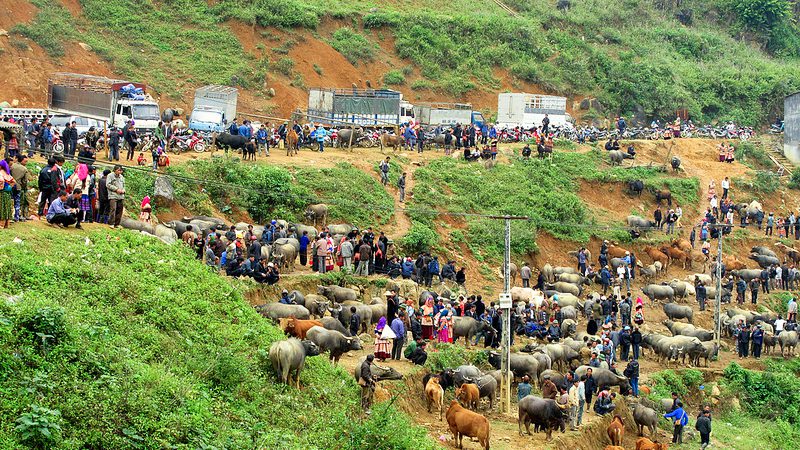
Can Cau Market
- Location: 20 km north of Bac Ha
- Characteristics: Every Saturday morning, Can Cau Market takes place. This market is primarily populated by H’Mong and Day ethnic people.
Sin Cheng Market
- Location: In the center of Sin Cheng Commune, 10km from Si Ma Cai District
- Characteristics: Despite being smaller than Bac Ha Market, Sin Cheng Market has everything. This market, which is held every Wednesday, is busiest at noon.
Coc Ly Market
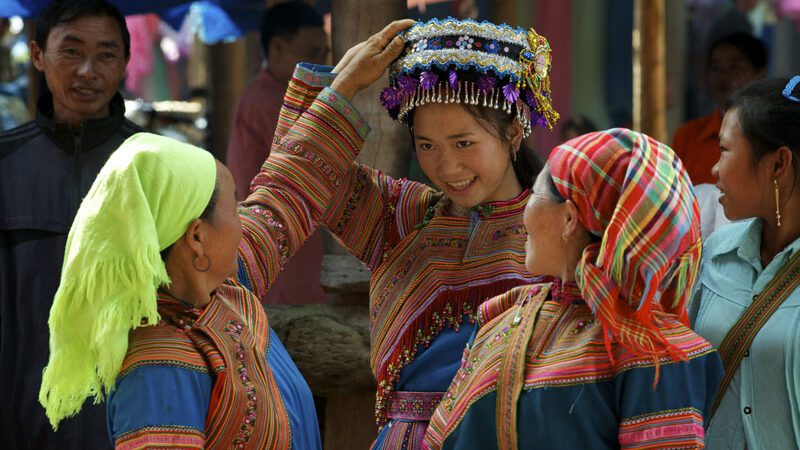
Coc Ly Market
- Location: 35km from Bac Ha
- Characteristics: Every Tuesday, the Coc Ly Market is held. This market is a gathering place for H’Mong, Black Dzao, and Nung people. After visiting this market, take a boat ride down the Chay River to admire the beauty of the Tay and H’Mong ethnic villages and photograph spectacular waterfalls.
2. Hoang A Tuong Palace
Hoang A Tuong Palace has a turbulent history, having been built in 1914 and completed in 1921. This palace belongs to Hoang Yen Chao, the father of Hoang A Tuong, a Tay person. Prior to 1945, Bac Ha was a semi-feudal, semi-colonial society in which the wealthy upper class, including Hoang A Tuong and Hoang Yen Chao, exploited the working class by occupying fertile lands and monopolizing the sale of essential goods like salt and food.
With a two-story structure, this location combines French and Chinese architectural styles. Its long and imposing corridor reflects a glorious past.
Location: In the center of Bac Ha Town
3. Fairy Cave (Dong Tien)
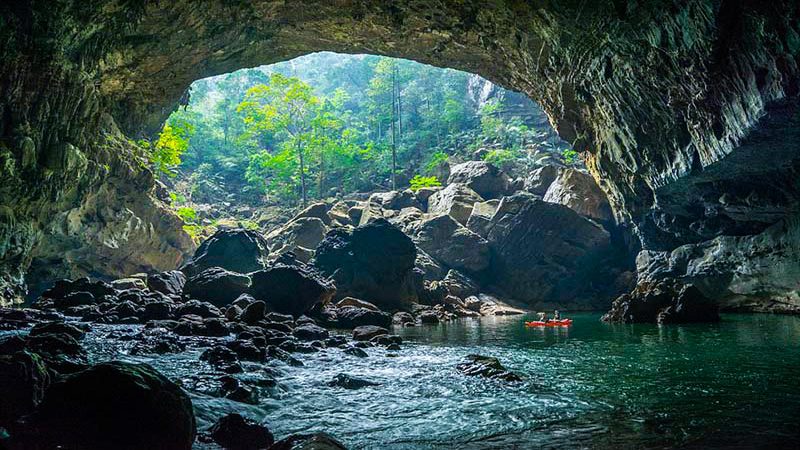
Hang Tien (Fairy Cave)
After visiting Coc Ly Market, this is a must-see location. The surrounding Chay River and fauna system add to Fairy Cave’s allure. To visit this cave, you must take a boat ride down the river.
4. Ban Pho Village
Ban Pho is located at the highest point in Bac Ha District and is primarily populated by H’Mong and Dao people. The main crop grown in this village is maize, with only a few families growing rice. Making alcohol, brocade weaving, and hammering are three traditional handicrafts in Ban Pho.
5. Fairy Mountain (Nui Co Tien)
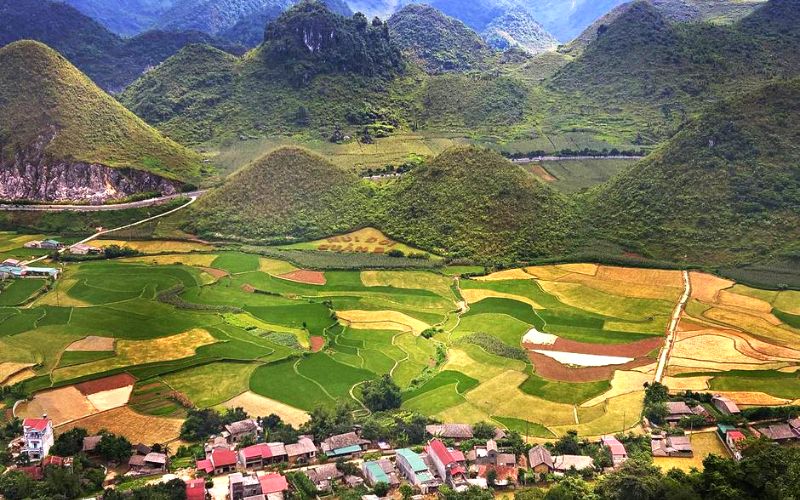
Nui Co Tien – Fairy Mountain
Fairy Mountain dominates the scenery from the north of Si Ma Cai District to Bac Ha township, rising over 1,000 meters above sea level. This is heaven for daring tourists who enjoy trekking, hiking, and conquering new peaks.
6. Bac Ha Temple
Bac Ha Temple, built in the nineteenth century, is dedicated to Vu Van Mat, a hero who defeated Northern enemies during Emperor Le Chieu Tong’s reign. Every year on the seventh lunar month, the Temple festival is held.
What to Eat in Bac Ha
While exploring Bac Ha Market, you must try the following delectable dishes to fully appreciate the region’s distinct culinary culture.
1. Banh duc ngo (Plain corn flan)
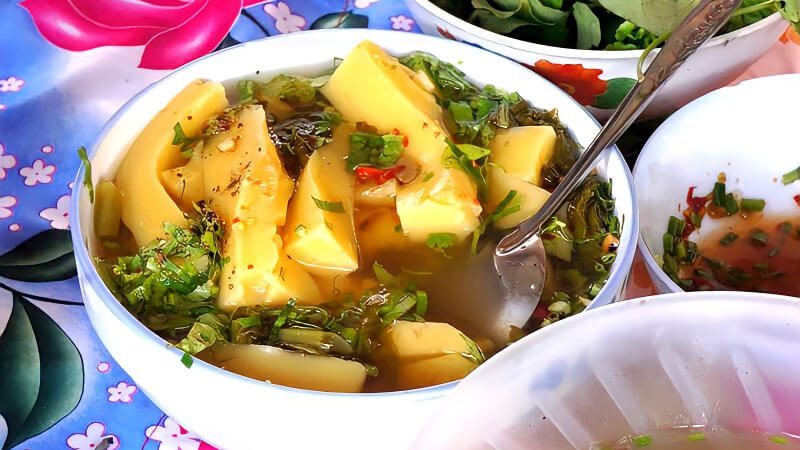
Plain corn flan – Banh duc ngo
Banh duc ngo, like regular banh duc (plain rice flan) in Hanoi, is made from corn grown by Northwestern ethnic people. Banh duc ngo is served in small pieces with broth, green onion, cilantro, and chili. This dish costs between VND 8,000 and 10,000 dong.
2. Men men (Rice mixed with corn)
Because corn is the main crop of the Northwestern mountainous ethnic tribes, men men is a popular dish. Only high-quality corn, neither too old nor too young, is used to make delicious men men. The corn is ground into powder and combined with the appropriate amount of water. The mixture is then cooked in a skillet until it has a distinct sweetness and color. A bowl of men men is inexpensive; for VND 10,000 dong, you can enjoy this dish’s delectable flavor and appealing aroma.
3. Xoi ngu sac (Five-color sticky rice)
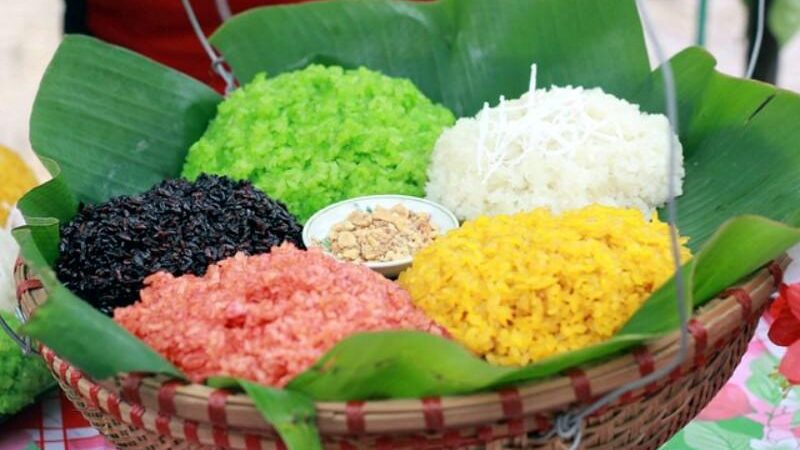
Xoi ngu sac – Five-color sticky rice
This is the Tay ethnic people’s traditional dish. It gets its name from the fact that it has five colors. According to their beliefs, these five colors represent the five elements of life: yellow is earth, green is plant, red is fire, white is metal, and purple is water.
This colorful sticky rice is made without the use of any chemicals; only natural leaves are used. To create different colors, the leaves are boiled before being placed in a large bowl with rice.
4. Pau po cu (Corn cake)
This is yet another corn dish that will make your trip to Bac Ha unforgettable. Corn is ground and wrapped in banana leaves before being steamed for several hours. Pau po cu is sticky, sweet, and fragrant. Locals consume it as a snack, but it can also be consumed for breakfast. Because it has been soaked in water, pau po cu can be stored for a week.
5. Thang Co (a special kind of hotpot)
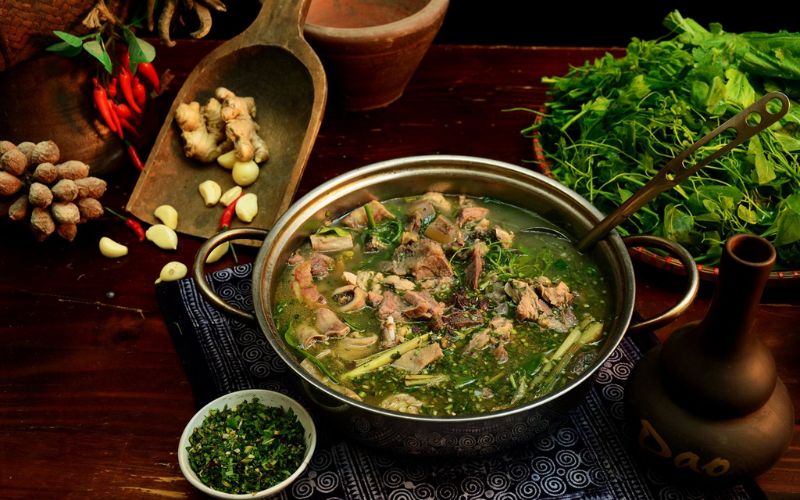
Bac Ha’s speciality – Thang Co
Thang Co is widely recognized as the H’mong ethnic group’s most traditional dish. This dish contains beef, buffalo, pork, and horse meat. However, locals frequently cook this dish with horse organs such as heart, liver, bone, and meat. All of these organs are placed in a large pot of water and cooked for an extended period of time. To cut down on the fat taste, some seasoning and vegetables are frequently served with the dish.
6. Banh Chen (Chen cake)
Chen cake is made with rice flour and corn flour. When Pau po cu is fragrant but dry and not sticky enough, locals add rice flour to make it stickier and softer. Chen cake, like Pau po cu, is wrapped in banana leaves and steamed in hot water.
7. Sour noodles
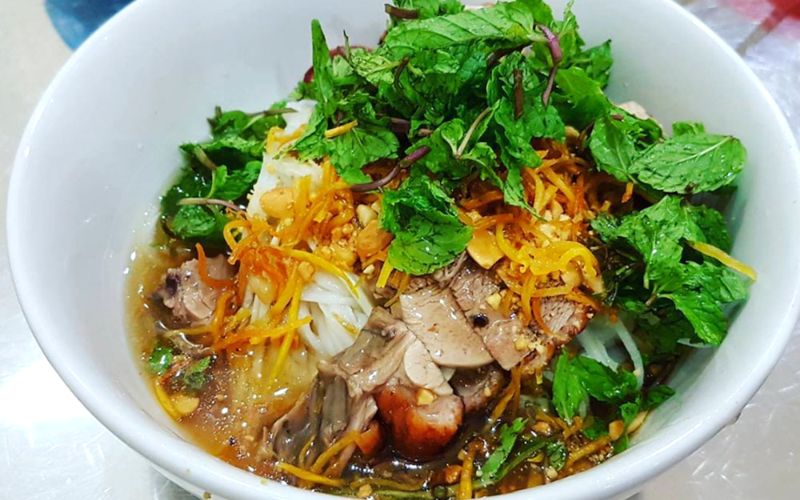
Bac Ha sour noodles
Despite using the same ingredients as Hanoi noodles, the taste of Bac Ha noodles is distinct and distinct. To make sour noodles, the chef uses essential ingredients such as pickles, finely chopped green vegetables (lettuce, basil), pounding roasted sesame and peanuts, a few seals for added flavor, and, of course, noodles and broth. You should add salt before tasting this food because it will be slightly fainter for people from other places. Sour Noodle is best served cold, making it an ideal summer dish. If you visit this place in the winter, your chances of tasting it are slim.
8. Corn wine
Corn wine is a specialty of the Hmong people in Ban Pho. It is made with water from the Hang De stream and corn grown on rocky mountains, particularly yellow corn from the Bac Ha commune of Lung Phinh.
We hope the information above is helpful to you. Feel free to contact us for more details and create your adventure now!
Start planning your tailor-made tour with 1-1 help from our travel advisors.
- Plan your tailor - made trip with a local expert
- Book securely with money-back guarantee
- Travel stress-free with local 24/7 support
